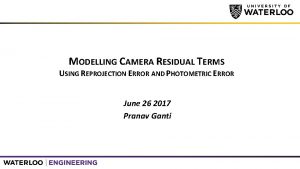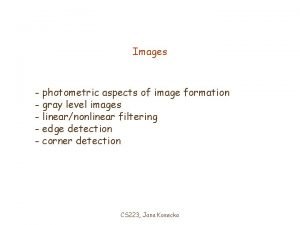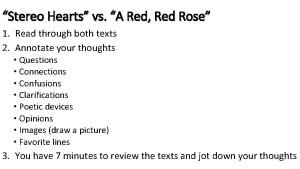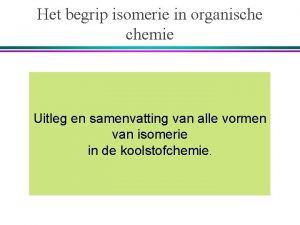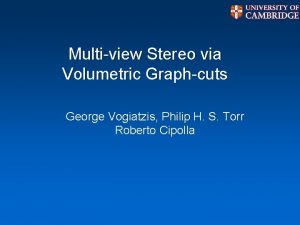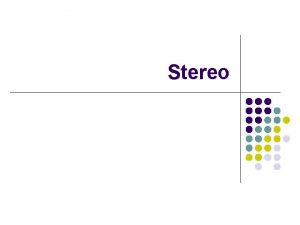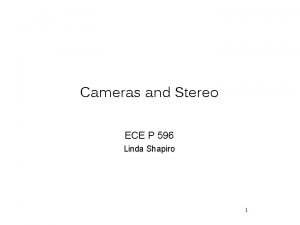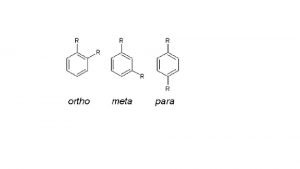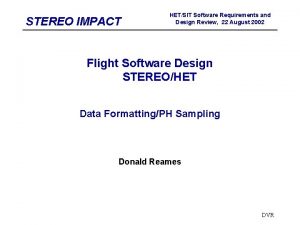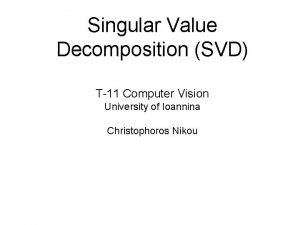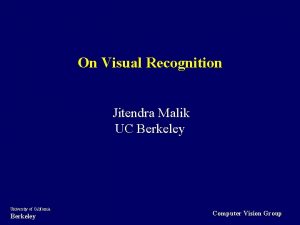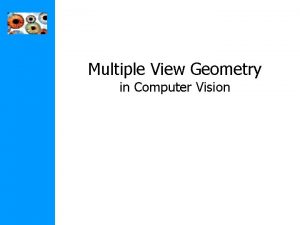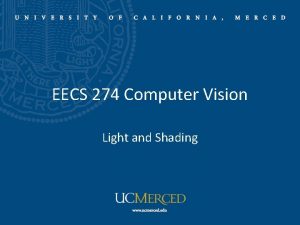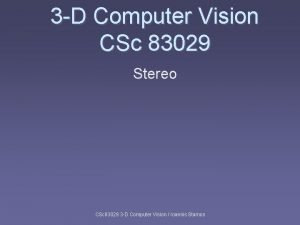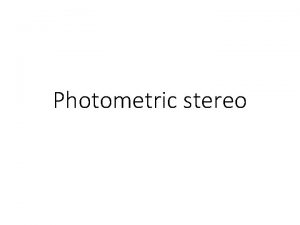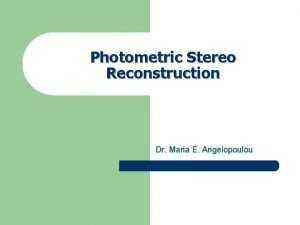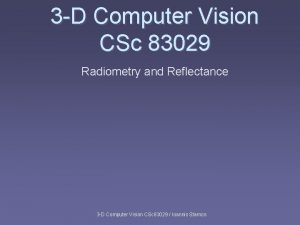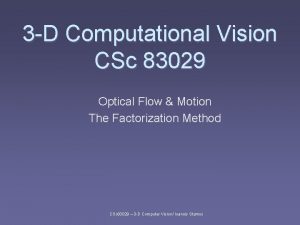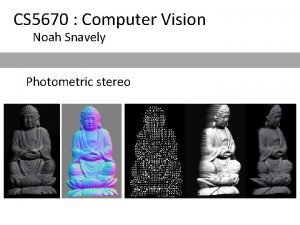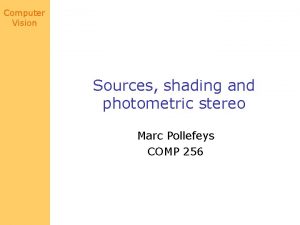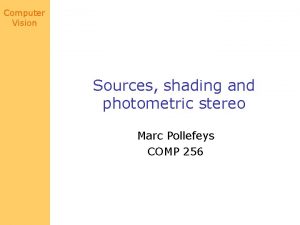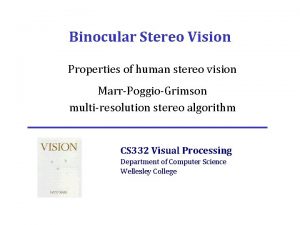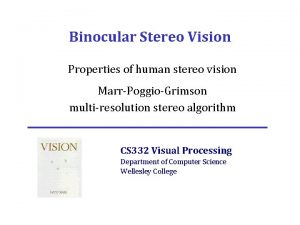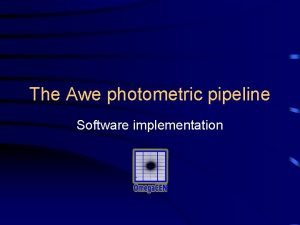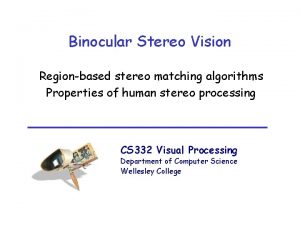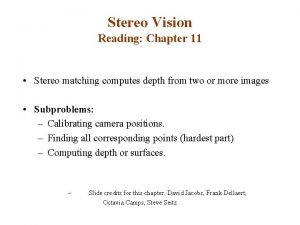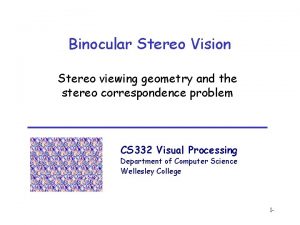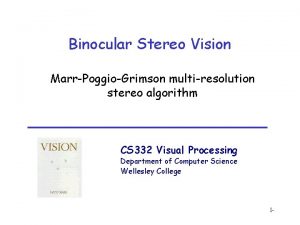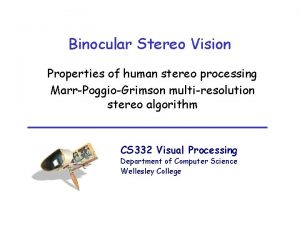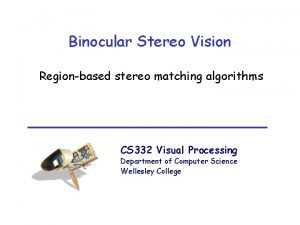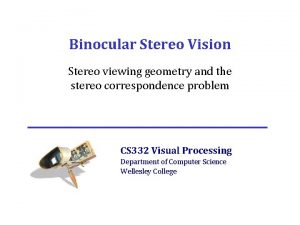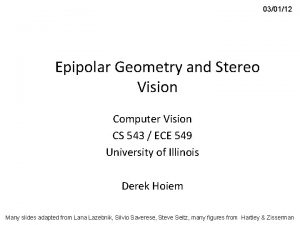3 D Computer Vision CSc 83029 Photometric Stereo






























- Slides: 30

3 -D Computer Vision CSc 83029 Photometric Stereo & Shape from Shading 3 -D Computer Vision CSc 83029 / Ioannis Stamos

Photometric Stereo & Shape from Shading § Technique for recovering 3 -D shape information from image intensity (brightness) § We will discuss: § Reflectance maps. § Photometric stereo. § Shape from shading. 3 -D Computer Vision CSc 83029 / Ioannis Stamos

Radiometry and Reflectance Image irradiance Brightness falloff 1 / F-number of lens Scene radiance We assume (calibration is needed) that: 3 -D Computer Vision CSc 83029 / Ioannis Stamos

Lambertian Reflectance Model I(x, y) p n θi v P or: s A Lambertian sphere k : Source brightness ρ’: Surface albedo (reflectance) ρ : Effective albedo (absorbs source brightness) : REFLECTANCE MAP 3 -D Computer Vision CSc 83029 / Ioannis Stamos

Lambertian Reflectance Model I(x, y) p n θi v P s A Lambertian sphere : REFLECTANCE MAP Relates Image Irradiance E to surface orientation for given source direction and surface reflectance 3 -D Computer Vision CSc 83029 / Ioannis Stamos

Representation of surface normal Z n ry Z=Z(x, y) Unit vector rx y Appendix A. 5 (Trucco) x 3 -D Computer Vision CSc 83029 / Ioannis Stamos

Gradient Space (p, q) Source z 1. 0 p q y x Surface normal can be represented by a point (p, q) on a plane! Source direction can be represented by a point (ps, qs)! **We want to calculate (p, q) from intensity I(x, y) 3 -D Computer Vision CSc 83029 / Ioannis Stamos

Gradient Space (p, q) Source z 1. 0 q y p x Surface normal Source direction Assumption: SOURCE DIR. IS CONSTANT FOR ENTIRE SCENE. 3 -D Computer Vision CSc 83029 / Ioannis Stamos

Reflectance Map (Lambertian) OR: Source z q Constant θi p y x 3 -D Computer Vision CSc 83029 / Ioannis Stamos ISO-BRIGHTNESS CONTOUR

Reflectance Map (Lambertian) ISO-BRIGHTNESS CONTOURS NOTE: R(p, q) is maximum when (p, q)=(ps, qs) 3 -D Computer Vision CSc 83029 / Ioannis Stamos

Reflectance Map (Lambertian) Examples. Where is the source with respect to the sphere? 3 -D Computer Vision CSc 83029 / Ioannis Stamos

Reflectance Map (Glossy Surfaces) 3 -D Computer Vision CSc 83029 / Ioannis Stamos

Shape from Shading ISO-BRIGHTNESS CONTOURS PROBLEM: Given 1) source direction 2) surface reflectance (ρ) 3) one intensity image I(x, y) Can we find 3 -Dunique surface orientation (p, q)? Computer Vision CSc 83029 / Ioannis Stamos

Two reflectance maps? 3 -D Computer Vision CSc 83029 / Ioannis Stamos

Two reflectance maps? Intersections: 2 solutions for p and q. What if we don’t know the albedo? 3 -D Computer Vision CSc 83029 / Ioannis Stamos

Photometric Stereo Use multiple light sources to resolve ambiguity In surface orientation. Note: Scene does not move – Correspondence between points in different images is easy! Notation: Direction of source i: or Image intensity produced by source i: 3 -D Computer Vision CSc 83029 / Ioannis Stamos

Lambertian Surfaces (special case) Use THREE sources in directions Image Intensities measured at point (x, y): orientation albedo 3 -D Computer Vision CSc 83029 / Ioannis Stamos

Photometric Stereo: RESULT INPUT 3 -D Computer Vision CSc 83029 / Ioannis Stamos albedo orientation

From Surface Orientations to Shape Integrate needle map 3 -D Computer Vision CSc 83029 / Ioannis Stamos

Calibration Objects & Look-up Tables Calibration: Useful when Reflectance Map Equations are uknown. Use Calibration sphere of known size and same reflectance as scene objects. Each point on the sphere has a unique known orientation. 3 -D Computer Vision CSc 83029 / Ioannis Stamos

Calibration Objects & Look-up Tables Illuminate the sphere with one source at a time and obtain an image. Each surface point with orientation (p, q) produces three images (I 1, I 2, I 3) Generate a LOOK-UP TABLE (I 1, I 2, I 3) -> (p, q) I 3 (p, q) ARRAY I 1 I 2 For an object of uknown shape but same reflectance, obtain 3 images using same sources. For each image Computer Stamos point use LUT to 3 -D map (I 1, Vision I 2, CSc 83029 I 3) ->/ Ioannis (p, q)

Photometric Stereo: Remarks (1) Reflectance & illumination must be known a-priori. (2) Local Method. (3) Major Assumption: No interreflections. Concave surfaces exhibit interreflections. 3 -D Computer Vision CSc 83029 / Ioannis Stamos

Shape from Shading § Can we recover shape from a Single Image? 3 -D Computer Vision CSc 83029 / Ioannis Stamos

Human Perception of Shape from Shading We assume light source is above us. Ramachandran 88 3 -D Computer Vision CSc 83029 / Ioannis Stamos

Human Perception of Shape from Shading We assume light source is above us. Ramachandran 88 3 -D Computer Vision CSc 83029 / Ioannis Stamos

Human Perception of Shape from Shading Surface boundaries have strong influence on perceived shape 3 -D Computer Vision CSc 83029 / Ioannis Stamos

Finding the Illumination Direction Assumption: The surface normals of the scene are distributed uniformly in 3 -D space Illumination direction Mean intensity Mean square intensity Mean image gradient 3 -D Computer Vision CSc 83029 / Ioannis Stamos

Shape from Shading Smoothness constraint 3 -D Computer Vision CSc 83029 / Ioannis Stamos

Shape from Shading Calculus of Variations -> Discrete Case: Is the average of the 4 neighboring values Iterative solution 3 -D Computer Vision CSc 83029 / Ioannis Stamos

Shape from Shading We know the normal at the contour. This provides boundary conditions. OCCLUDING BOUNDARY 3 -D Computer Vision CSc 83029 / Ioannis Stamos
 Photometric stereo
Photometric stereo Ronen basri
Ronen basri Geometric and photometric image formation
Geometric and photometric image formation Photometric reprojection error
Photometric reprojection error Photometric image formation
Photometric image formation 11 stereo
11 stereo Human vision vs computer vision
Human vision vs computer vision Tcp stereo
Tcp stereo Theme of stereo hearts
Theme of stereo hearts Spiegelbeeldisomerie
Spiegelbeeldisomerie Functie isomeren
Functie isomeren Would you mind turning down the music
Would you mind turning down the music Know the lingo poetry answer key
Know the lingo poetry answer key Multiview stereo
Multiview stereo Would you mind turning your music down
Would you mind turning your music down Fusion stereo problems
Fusion stereo problems Stereo science center
Stereo science center Stereo
Stereo Xhtem
Xhtem Stereo isomeria
Stereo isomeria Hetsit
Hetsit Figurative language in stereo hearts
Figurative language in stereo hearts Singular e plural
Singular e plural Would you mind turning down your stereo
Would you mind turning down your stereo 16-385 cmu
16-385 cmu Kalman filter computer vision
Kalman filter computer vision T11 computer
T11 computer Berkeley computer vision
Berkeley computer vision Multiple view geometry in computer vision.
Multiple view geometry in computer vision. Font detector
Font detector Radiometry in computer vision
Radiometry in computer vision



